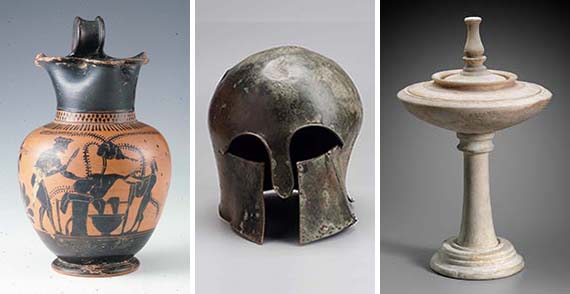Beginning in the fall of 2016, conservators will treat a variety of ancient Greek objects in preparation for the late 2017 opening of a new, permanent gallery centered on the theme of daily life in ancient Greece. The conservation work will be conducted on view in gallery 117 over the next year, giving visitors the rare opportunity to watch treatments in progress and get a glimpse of activities which normally take place behind the scenes. Updates on the project, to be posted below, will include information on the treatments ongoing in gallery 117, as well as treatments carried out in the Objects Conservation Laboratory.
Throughout the year, there are multiple other ways to follow this project. Questions from the public are welcome and can be submitted to conservation@mfa.org. Conservators will also be offering regularly-scheduled Spotlight Talks and can field questions in person. Highlights will be shared through the Museum's social media outlets using the hashtag #mfaconservation.
The Objects
Opening in late 2017, the new Greek gallery will be organized thematically. It will offer an engaging visual introduction to daily life in ancient Greece in the 6th and 5th centuries B.C. Funerary rituals, an important part of daily life, will be explored, followed by the themes of women, children, and family; objects on display will feature scenes of women weaving, children playing, and marriage rituals. The issue of masculinity in ancient Greek society will be highlighted through works of art that represent the world of the warrior, athletic competition, and the origins of the Olympic Games. The final thematic focus of the gallery will center on the marketplace, with objects that depict men of different trades, such as a shoemaker, a butcher, and an olive oil merchant, as well as a group of weights and measures used in commerce.

Conservation Strategy
Preparations for the new gallery involve the documentation and conservation treatment of more than 260 objects, including ceramics and objects made from stone, bronze, silver, glass, and bone. Work on this project began in the spring of 2016. After objects were selected for exhibit, conservators completed a survey of the artworks, assessing each object's condition, treatment history, and special requirements for display. Conservators then made specific recommendations for the treatment of each object, most importantly to address the question: What will it take to make this object safe for display? The treatment recommendations include time estimates for the conservation of each object, allowing conservators to prioritize their work, in collaboration with curators. Other questions to be addressed during conservation: What are the old repair materials used on the objects and how may they be affecting the objects' condition and aesthetic appearance? How can conservators safely remove these repairs and stabilize the objects? What can be learned about the objects' original manufacture and appearance through careful examination and scientific analysis?
The objects that were assessed for the Daily Life in Ancient Greece gallery range greatly in terms of condition. Some are objects in poor condition and require in-depth conservation treatment in order to be safely handled and displayed. Others are in fair to good condition requiring moderate treatment. Some, remarkably, given their age of more than 2,000 years old, are in excellent condition and may require only documentation. A major factor affecting an object's condition are the materials from which it is made. Organic materials and glass, for example, are very susceptible to damage and thus fewer examples survive to this day. By comparison, ceramics are quite durable and so are more prevalent, but they can still be damaged by breakage and soluble salt contamination.
In preparing for the opening of this new gallery, conservators will collaborate with Museum staff from many departments, including curators, conservation scientists, mountmakers, conservation engineers, and exhibition designers. Progress on all aspects of the work involved will be posted here, with a focus on conservation treatment.
